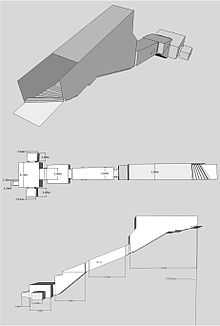KV16
From Wikipedia, the free encyclopedia
| KV16 | ||
|---|---|---|
| Burial site of Ramesses I | ||
 | ||
| Location | East Valley of the Kings | |
| Discovery Date | 10 October 1817 | |
| Excavated by | Giovanni Belzoni | |
| Previous : KV15 |
Next : KV17 | |
Tomb KV16, located in the Valley of the Kings in Egypt, was used for the burial of Pharaoh Ramesses I of the Nineteenth Dynasty. It was discovered by Giovanni Belzoni in October 1817.
As Ramesses I ruled for less than two years, his tomb is rather truncated (only twenty-nine metres long), consisting of two descending staircases, linking a sloping corridor and leading to the burial chamber. Like the tomb of Horemheb (KV57), the tomb is decorated with the Book of Gates. The sarcophagus, still in place in the final chamber, is constructed of red quartzite.

Isometric, plan and elevation images of KV16 taken from a 3d model
References
- Reeves, N & Wilkinson, R.H. The Complete Valley of the Kings, 1996, Thames and Hudson, London.
- Siliotti, A. Guide to the Valley of the Kings and to the Theban Necropolises and Temples, 1996, A.A. Gaddis, Cairo.
External links
- Theban Mapping Project: KV16 - Includes description, images, and plans of the tomb.
Coordinates: 25°45′00″N 32°36′51″E / 25.75°N 32.6143°E
| |||||||||||
This article is issued from Wikipedia. The text is available under the Creative Commons Attribution/Share Alike; additional terms may apply for the media files.